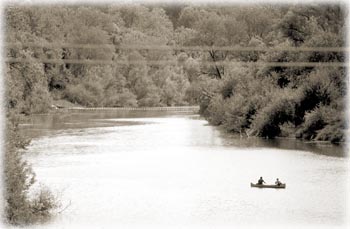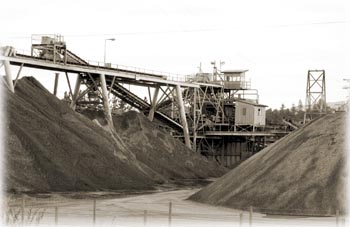![[MetroActive News&Issues]](/gifs/news468.gif)
![[MetroActive News&Issues]](/gifs/news468.gif)
[ Features Index | Sonoma County Independent | MetroActive Central | Archives ]
Russian Roulette
As steelhead lurch toward extinction, Sonoma County enters an era
of environmental reckoning. A river ecosystem report.
By Christopher Weir
Last month's listing of the Russian River steelhead trout as "threatened" under the federal Endangered Species Act may have generated more questions than answers, but it is the ugliest confirmation to date that Sonoma County is on the verge of ecological critical mass. Warned by the National Oceanic and Atmospheric Administration that "extinction is not an option," local agencies have vowed to orchestrate broad restorative and management measures to rehabilitate the Russian River and its tributaries.
But while the federal government has promised to unleash more than mere sound bites upon the county if it fails to solve its watershed conundrums, developmental forces remain poised to push the region's environmental envelope until it bursts with bleak irony.
"You've got the Board of Supervisors approving gravel mining [in the riverbed] during the same period they're putting money into programs to plant trees along the riverbanks," says Joan Vilms, president of Friends of the Russian River. "You've got the Sonoma County Water Agency pursuing an EIR process for nearly a doubling of their water appropriations from the Russian River at the same time they're spending millions of dollars on piecemeal restoration projects.
"Restoration is certainly an issue, but nature has tremendous recuperative powers. The first action that needs to be taken--and which nobody is doing--is stopping the damage."
For now, the National Marine Fisheries Service and the California Department of Fish and Game will be closely monitoring how Sonoma County responds to the challenge of reversing steelhead decline and resurrecting watershed viability. Both agencies have promised to take active roles in coordinating management plans
Clearly, the most fascinating aspect of the steelhead situation is whether or not broad-scale cooperation can eventually tame the special- and self-interests that continue to trash the Russian River watershed. "I'm a little bit skeptical that it can work, but I firmly believe that it's the only thing that can work," says Bill Cox, local fishery biologist for the Department of Fish and Game. "To simply try to go out and use regulations to protect steelhead resources hasn't worked in the past and really won't work in the future."
Caught in the intensified crossfire over the steelhead and its habitats are county agencies, municipalities, dairy farmers, winegrowers, and development interests. Virtually no one is without a stake in the issue, and all stand to be impacted by the recent listing. The question is not just what those impacts will be, but how they will transpire and to what degree they can be mitigated.
Paradox: Activist Joan Vilms contends that a $200 million plan to recycle Santa Rosa wastewater for agricultural use, including that now dumped into the river, could fuel more farm development and further strain the river.
SONOMA COUNTY'S split personality as the North Bay's agricultural crown jewel and suburban ground zero has overtaxed the regional river system. Meanwhile, related mismanagement of land and water resources has forged a watershed emergency state, decimating habitats and sabotaging local wildlife. The species now in question is not some esoteric amphibian or reptile. Rather, it's a fish noted for its powerful physique and elegant grandeur, a fish that weighs up to 20 pounds and navigates miles of tributaries.
The steelhead trout is, in essence, an indicator species, and it is clearly indicating that the Russian River watershed--1,500 square miles shared by Sonoma and Mendocino counties--has become fundamentally dysfunctional.
"The steelhead uses a fairly wide range of habitats," Cox says. "If they are in pretty bad shape, that's a strong suggestion that our streams and watersheds are in pretty bad shape."
Unfortunately, Sonoma County's fisheries issues represent a microcosm of the entire West Coast, where watershed disruption is far more the norm than the exception. Some might take comfort in the notion that the Russian River steelhead merits a less critical "threatened" listing while the Southern California steelhead is now classified as "endangered." Others would suggest that being one step removed from Santa Barbara's or Los Angeles' river conditions is not only a dubious distinction, but perhaps a disturbingly prophetic symptom of things to come for both the local environment and Sonoma County's quality of life.
Born in freshwater river tributaries, steelhead juveniles migrate to estuaries, then to the ocean. After one to three years spent foraging amid the Pacific, they return to their native rivers and tributaries for spawning. Unlike salmon, a single steelhead can make such a journey more than once.
Just 50 years ago, the Russian River and its tributaries supported an annual steelhead run of up to 90,000 fish. That number has declined by at least 90 percent, leaving fewer than 10,000 steelhead in local waters annually. Some estimates place the run as low as 1,000. Water diversions, increasing sedimentation from gravel mining and steep-slope planting of vineyards, riverbank manipulation, and loss of riparian habitats are just some of the interconnected developments that have contributed to the steelhead's precipitous decline.
The listing of the Russian River steelhead trout as threatened comes on the heels of a similar listing for local coho salmon last April. While the coho is a hardy and dynamic species as well, the steelhead listing was met with more morbid anticipation primarily because the trout's wide-ranging behavior not only suggests a broader prognosis for watershed health, but also represents greater impacts on a vast spectrum of developmental and agricultural interests.
"Coho occur in a select few streams, mostly in heavily forested areas where there's not going to be a lot of conflict with agriculture, development, or flood-control measures, but mainly with timber harvesting," Cox says. "Steelhead occur in streams that flow through downtown Santa Rosa, in east Marin streams where there's a lot of development, in areas where there are flood-control issues.
"So I think the fear that drove all the interest in the steelhead listing is that it could affect many aspects of human activities."
According to Cox, a region's dominant watershed activity is also the one likely to cause the most damage to river and tributary habitats. So whereas timber harvesting would be the primary source of problems farther north, he says, agriculture--mainly vineyards--remains the Russian River region's primary culprit.
Still, Cox says, "it's hard to generalize. Some grape growers have been sensitive to riparian areas and erosion control on their lands. Others have not been sensitive to that, and we've got places where the riparian vegetation has been cleared right up to the edge of the water, and places where very steep lands have been cultivated with no erosion controls. We've lost large amounts of soil off the land and into the streams."
Loss of riparian vegetation not only eliminates the woody labyrinths favored by spawning fish and their offspring, but also undermines stream bank stability, encouraging erosion and subsequent sedimentation that throttles underwater spawning habitats.
On a brighter note, Cox suggests that successful cooperation between Sonoma Valley winegrowers and the local Resource Conservation District can be seen as a model for the type of collaborative measures that the NMFS would like to employ as an alternative to increased federal pressure.
Yet, despite all the environmental enlightenment and regulatory threats that have transpired over the past several years regarding watershed health, some grape growers remain mired in a cycle of renegade exploitation.
A Bridge Too Far: Winery owner and conservationist Martin Griffin warns that new agricultural projects along the river could do irreparable harm.
"Right down here by the Wohler Bridge, just in the last week, somebody has cleared about 10 acres right up to the edge of Mark West Creek," says Dr. Martin Griffin, local conservationist and owner of the Hop Kiln Winery. "It's tragic. They left a few big trees, but those will slide right into the creek."
BEFORE THE DECISION [to place steelhead on the threatened species list], you had people saying, 'Life as we know it will change if the fish gets listed,'" Vilms says. "Well, the fact is that life as we know it had already changed, which is why the fish got listed. The listing is a result, not the cause. The fish are not the problem. The fish have a problem."
And now that Sonoma County's fish have a problem, so do a number of local agencies, most notably the Sonoma County Water Agency and Santa Rosa's Board of Public Utilities, which is still considering an option to dramatically increase the controversial dumping flow of that city's wastewater into the river. By essentially requiring these agencies to comply with stricter environmental considerations, the listings of the coho and steelhead promise to play an integral role not only in watershed management, but in the county's long-term growth and development .
With the hot breath of an imminent steelhead listing breathing down its neck, the Sonoma County Water Agency this spring released its Russian River Action Plan, a sweeping fisheries restoration and management blueprint that presumes to orchestrate a healthier future for the Russian River and its tributaries. While the plan suggests an array of options, ranging from fish ladders to sewage treatment upgrades, it commits to none.
"It's not a working document that identifies a particular project," says Ellen Dowling, public information officer for the Sonoma County Water Agency. "It's a document that identifies needs within this region to improve fisheries conditions."
Nevertheless, the plan was cited by the NMFS as a major factor in the decision to list the steelhead as threatened rather than endangered. The implication is that the federal government expects much of the plan to be executed. Dowling says that the plan will evolve to reflect funding, prioritization, and interagency collaboration.
Just after the steelhead listing, the county Board of Supervisors--the water agency's "board of directors"--voted to authorize $394,000 for fiscal 1997-98 to set the plan in motion and develop a memorandum of understanding between the agency, the NMFS, and the U.S. Army Corps of Engineers. The Russian River Action Plan could ultimately cost $340 million. Central to the plan is a $200 million proposal to integrate county sewage plants within a 45-mile distribution pipeline that would divert highly treated wastewater from the river and its tributaries, instead allocating it to north county farmers and winegrowers.
Says Dowling of the proposal, "The benefits are multiple, from offsetting freshwater diversions to reducing discharges to surface waters to providing water sources for agriculture."
Vilms counters that the proposal could simply fuel continued agricultural development, further straining the river system. "I think it's laudable that the county wants to reuse wastewater, but they are really stretching to show how it would be beneficial to the fish without actual contracts that would make wastewater a replacement for tributary water. . . .
"Our concern about the reuse is simply that it conceivably or potentially allows greater expansion of agricultural use into natural lands that could impact the fish."
Meanwhile, Santa Rosa's long-awaited wastewater project is not only coming under continued fire, but may also be upstaged by the Sonoma County Water Agency's wastewater pipeline plan. Santa Rosa is exploring several options, including the possibility of raising the allowable wintertime discharge level from 1 percent of the river's flow to 20 percent.
"Just a couple of weeks ago it seemed like it was a foregone conclusion that they were going to select a 20 percent discharge option," says Russian River Watershed Protection Committee spokesperson Brenda Adelman. "Now there are all kinds of shifting and moving of the various agencies since the listing. . . . The water agency is sort of upsetting the apple cart in response to the feds, and nobody knows how it's all going to play out. It's going to be a very fascinating story."
The water agency has approached Santa Rosa about consolidating the city's subregional system with the agency's sanitation districts and operations facilities to harness as much recycled water as possible to be utilized through this distribution system. For now, however, it remains to be seen to what degree Santa Rosa is enamored with the water agency's courtship. "The Board of Public
According to Adelman, Santa Rosa's wastewater is already wreaking an ecological toll. "The river has become very high in nutrients," she says. "There are all kinds of blooms, all kinds of algae and other degradation."
She also accuses Santa Rosa of "playing games" with its discharge
numbers. "Even though their permit says in no case shall you discharge over 5 percent [of the river flow], they've got the staff at the Regional Water Quality Control Board to say, 'Yeah, you can do a seven-day average, and you can base your discharge on the high flow of the day before in the river.' And so by the time their discharge reaches the river, it can be 10 or 15 percent."
Retorts Dan Carlson, capital projects coordinator for Santa Rosa, "Our permit is administered by the regional board, and they tell us how to determine the percentages, and we do what they authorize us to do. . . . Usually we're well below [the 5 percent limit]. Sometimes you could find that the percentage is slightly above, but from the standpoint of the permit, it's what is allowed."
The direct effects of wastewater on wildlife remain a matter of debate. "There's never been a correlation of any short-term effects with the river health, fish, or anything else," Carlson says. "It's all long-term things. So percentages, whether they're slightly high or slightly low, aren't changing whether there's a health risk or fishery risk or anything else."
Replies Adelman, "Their own tests show that in some cases there's impairment on the fishery from their wastewater. They just think people don't know that."
THE RIVER is a living system with an intelligence that knows and seeks its needs," Vilms says. "And it needs its gravels, it needs its floodplains, it needs the room to do the work that rivers do."
Rock Hard: Companies like Syar Industries Inc. of Healdsburg rely on gravel mining for their livelihood. But conservationists say the operations put too much stress on an already overtaxed ecosystem.
Developmental forces, however, continue to underestimate the Russian River's intelligence. Its flow manipulated by dams, its volume decimated by diversions, its banks streamlined by flood-control projects, and its waters choked with sediment, the river has become less a living system than a refraction of the county's hyperactive growth. The perpetual-motion machines of gravel mining, timber harvesting, and grape growing fuel the construction and tourism that in turn intensify the increasing demands and impacts on the watershed.
Anyone searching for a crystal ball to catch a glimpse into the region's future might want to start with the Sonoma County Water Agency's application for a 40 percent increase of its river diversions to "accommodate" anticipated growth in Sonoma and Marin counties.
Such anticipated growth, however, might itself become endangered if current growth patterns fail to accommodate the coho and steelhead.
The possibilities that could transpire if the listings are ratcheted from "threatened" to "endangered" include rigid restrictions on agricultural diversions for irrigation, moratoriums on agricultural or municipal expansions, stricter regulations for logging and mining operations, and a major cutback on the 160,000 acre-feet of water currently diverted to the Russian River from the Eel River.
Unfortunately, such threats might prompt special interests to take as much as they can, as fast as they can.
"The mining firms are not about to give up," Griffin says. "They've gotten much more aggressive since the listings of coho and steelhead, and they're applying for permits up and down the river. We're disillusioned by the county continuing to issue mining permits in the face of the listings."
According to Griffin, 800 county agricultural acres--most of them vineyards--have been converted and mined, and are now "open pits that are taxed as wasteland."
"Gravel mining has a powerful impact on habitats," he says, "especially the in-stream mining that is being stepped up right now."
Floodplain mining also causes habitat problems, he adds. "Rivers constantly migrate back and forth across their floodplain, and eventually they capture these gravel pits that are deeper than the riverbed. It has a devastating effect on the fishery habitat."
According to Cox, however, since mining in the main river doesn't occur in the middle of migration season, "it has very little effect on steelhead."
As for logging, he explains, "Timber harvest practices are vastly better than they were 15 or 20 years ago. . . . But any logging is going to cause some erosion and sedimentation. It's something that I believe the state Board of Forestry is going to have to address in revisions to timber harvest rules as a result of the listing of the steelhead and coho."
For now, speculation reigns as to just how Sonoma County's environmental challenge will manifest at ground level. The steelhead listing won't even become official until it's entered into the Federal Register later this month, and it may take a year or two before the NMFS and California Department of Fish and Game can assess the county's progress.
Subsequent to the steelhead listing, the National Oceanic and Atmospheric Administration and the NMFS were charged with being deliberately "circumspect" about their regulatory firepower.
But the fisheries service's Patrick Rutten was anything but circumspect when he said that federal controls "will get a hell of a lot tighter, real fast" if Sonoma County fails to take advantage of its "window of opportunity."
That opportunity belongs not just to the coho and steelhead, but also to the residents of Sonoma County.
"Our watersheds are not in good condition," Cox concedes. "They may support us for the next 50 years. But unless we are so selfish as to say we don't care what we leave our children, then this is the wake-up call to improve not just the fish's environment, but our environment."
[ Sonoma County Independent | MetroActive Central | Archives ]
Copyright © Metro Publishing Inc. Maintained by Boulevards New Media.

Michael Amsler
and monitoring resources, but are neither inclined nor equipped--at least for now--to establish a ground-level environmental police state in the Russian River region.

Michael Amsler

Michael Amsler
Utilities [members have] not made up their minds one way or the other," says Pat Fruiht, community affairs coordinator for Santa Rosa. "I think it's too early in the game to anticipate what they might do."

Michael Amsler
From the Sept. 4-10, 1997 issue of the Sonoma County Independent.